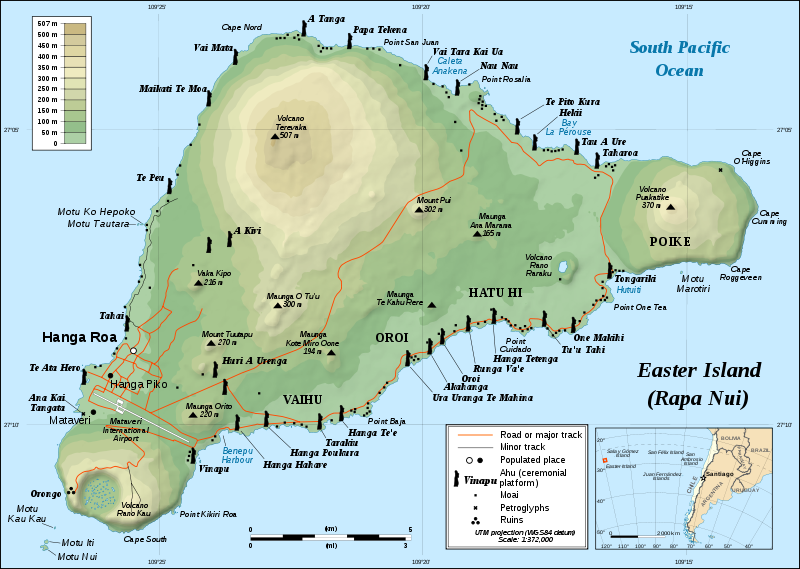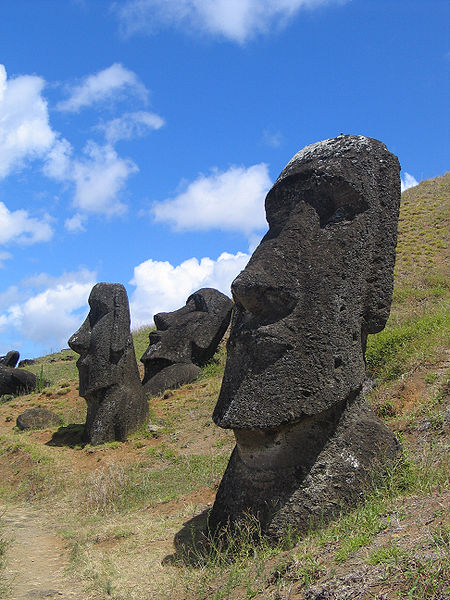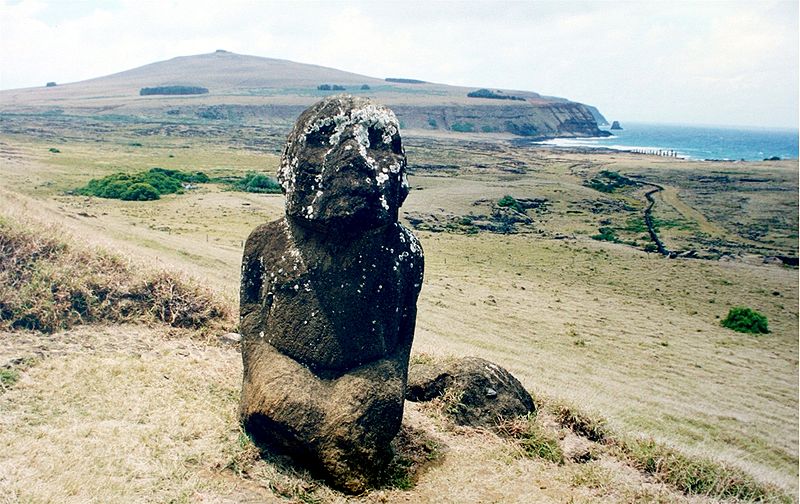Those who follow this blog will know that it’s been a while since the previous post. This is due to other developments that may be featured in another post quite soon. In the meantime, some food for thought. (Don’t miss the second half.)
Summary
Five hundred years ago Easter Island was a subtropical paradise. Rich and varied vegetation with an abundance of moist broadleaf forest unique to that island; highly fertile soil that by one account “could grow all the crops you’d need with just three days a year of cultivation”; safely clear of the tropical cyclone & hurricane belt; temperatures varying from 64 degrees in winter to 82 in the summer; sensible rainfall patterns; possibly the world’s richest variety of seabirds, with resident colonies of over thirty species; abundant fishing in the seas around the island.

Four hundred years later the trees had all gone, the seabird colonies had gone, along with the five indigenous inland bird species now all extinct. Extensive soil erosion had drastically reduced the island’s ability to provide those crops of bananas, sugar cane and sweet potatoes that could formerly feed the population with such ease. Survival was no longer a straightforward matter for the drastically reduced numbers that didn’t even have the wood to build boats for fishing trips.
 But no matter. They did have a monument to their greatness – almost nine hundred of them, in fact. Massive stone statues hewn from volcanic rock and transported far and wide across the island, using – yes, you guessed it, those tree trunks.
But no matter. They did have a monument to their greatness – almost nine hundred of them, in fact. Massive stone statues hewn from volcanic rock and transported far and wide across the island, using – yes, you guessed it, those tree trunks.
All apparently in some grotesque game of ‘keeping up with the Joneses’, or preferably going one better, an insane riot of egotistical pretension.
But at what a price – and what’s the take-home message for us?
Paradise Lost
As evidence for some form of deity it’s a sure-fire winner: a parable set in a coral sea. The stone heads of Easter Island (actually full-body statues, usually kneeling, but with large heads) are supposedly devoted to ancestors – but let’s be honest, folks, they’re actually a massive ego trip. What Easter Island is telling us above all else is “If you plunder your environment for the purpose of boosting and parading your own ego, the odds are that you’ll come a cropper”.
In fact we don’t need a deity to tell us that, it must surely count as a natural law. The sick thing is that the Rapanui – the islanders – created these tributes to their ancestors in the hope and expectation that this would ensure their own prosperity – good crops and all that. In fact it did exactly the opposite.
 Of course we in the civilised West would never succumb to such foolish superstition. We sensibly put our faith in real tangible benefits. According to the news reports, a major indicator that we’re out of the doo-doo and back on track (to where?) would be a return to economic growth – the more the better.
Of course we in the civilised West would never succumb to such foolish superstition. We sensibly put our faith in real tangible benefits. According to the news reports, a major indicator that we’re out of the doo-doo and back on track (to where?) would be a return to economic growth – the more the better.
Economic growth. On a planet of finite resources. Why does that make me think of the trees on Easter Island? And why should the totem of ‘economic growth’ confer benefits on the average Joe or Jo, any more than a stone head in the back yard would? Isn’t that just another form of superstition? We’ve seen where the god of ‘economic growth’ leads us – in the Gulf of Mexico, in Bhopal, in the trillion-dollar bailouts.
 ‘Ozymandias’ should be required reading for all business tycoons (those from that centre of commerce, the city of London, should scroll down to also read Horace Smith’s version).
‘Ozymandias’ should be required reading for all business tycoons (those from that centre of commerce, the city of London, should scroll down to also read Horace Smith’s version).
Overshoot
The plain fact is, this space-island of ours is vastly overpopulated. Just as a spill of nutrient into a lake can trigger a rapid spurt in growth of algae, that then burns itself out when the nutrient runs out, so the petroleum revolution of the last century or so has underwritten a massive boost in agricultural and technological productivity that’s supported a major expansion in the numbers of ‘human algae’.
But the oil, like that nutrient, won’t be available forever. Some say we’ve already passed the point of peak oil production, others put it within the next few years. Those who point to the tar shale deposits need to look at the net return on energy input (taking everything into account), those who believe there will always be another oilfield just round the next bend make the Rapanui seem positively hard-headed.
It’s no accident that there is major political unrest in those parts of the world that still have oversight of sizeable amounts of oil; those who preach ‘economic growth’ know exactly what’s needed to fertilize that growth. The as-yet small, but steadily increasing, practice of converting former food crops into biofuels – generally not for the local population – is already a contributory factor in food price riots breaking out around the world.
So what’s to be done?
Lifeboats
The Easter Islanders were doubly caught by the deforestation of their small island. That made it less possible for the island to support them – but it also made it impossible for them to build boats to escape to other more hospitable lands. Certainly, depredations by rats impacted seriously on the rate of new tree growth – but fixation on statue-carving to the extent of not seeing the wood for the lack of trees (to paraphrase a well-known saying) is surely a failing that merits a special mention in the Darwin Awards. To leave yourself no way of escape if all else fails is the mark of a species that doesn’t seem to want to survive.
 Professor Stephen Hawking has observed that the continued survival of the human race over the next hundred years is very much open to question if we continue to be tied to this one planet. To quote his words, we shouldn’t be putting all our eggs in one basket – i.e. earth. To look at it positively, the stresses on our race and on our planet at this time can be seen as evolutionary pressures driving us out to take our place in the cosmos (my words, not his) – evolution is rarely a comfortable process.
Professor Stephen Hawking has observed that the continued survival of the human race over the next hundred years is very much open to question if we continue to be tied to this one planet. To quote his words, we shouldn’t be putting all our eggs in one basket – i.e. earth. To look at it positively, the stresses on our race and on our planet at this time can be seen as evolutionary pressures driving us out to take our place in the cosmos (my words, not his) – evolution is rarely a comfortable process.
If Hawking is right – as he surely is – we shouldn’t be waiting, as the Rapanui did, for the last tree to fall (metaphorically speaking in our case). The time to be designing our lifeboat is now. And part of that design process must surely be openness to re-examination of scientific assumptions that have stood without proof for over a century.
There’s little doubt that, if it were made a serious priority, interstellar travel within realistic time-scales could be a reality within fifty years, maybe even thirty. That could provide a much-needed relief valve for the pressure-cooker environment that we’ve created for ourselves on this planet, as well as giving a real sense of purpose that seems to be lacking at present in the field of human endeavour. It would also give our beautiful mother-planet, and those of all species that stay with her, a bit of breathing space.
 It appears that we have two choices: to end up as a global Easter Island – or to pursue our destiny out there among the stars. Not really a choice at all, is it?
It appears that we have two choices: to end up as a global Easter Island – or to pursue our destiny out there among the stars. Not really a choice at all, is it?
Finally, I offer you the last two stanzas of a poem on this subject that came to me unexpectedly a year and a half ago:
Mother Earth’s breasts
grow low on oil.
Her larders
grow low on fish and grain.
Her human offspring,
still attached to her
by the umbilicus of gravity,
stretch her to bursting point.
We have been tied to her apron strings
too long,
like an overgrown adolescent
in need of a new challenge,
in need of space to stretch ourselves.
Like tightly-packed thistledown
on a ripe seed-head
we crowd far too close,
in need of that new lebensraum.
The Final Frontier beckons.
———————–
For a new scientific perspective, see here.
If you’d like to be informed about future posts: subscribe (free)
———————–
Picture credits
Earth Picture: NASA
Space pic: NASA, ESA & Hubble Heritage Team
(Acknowledgement: D. Gouliermis, Max Planck Inst. of Astronomy)
All other pictures: Wikipedia Commons
Note: Comments significantly over 250 words will be truncated.
Longer comments having relevance and merit may be reproduced in full on the overspill page.